Benlin Liu
Visual Representations inside the Language Model
Oct 06, 2025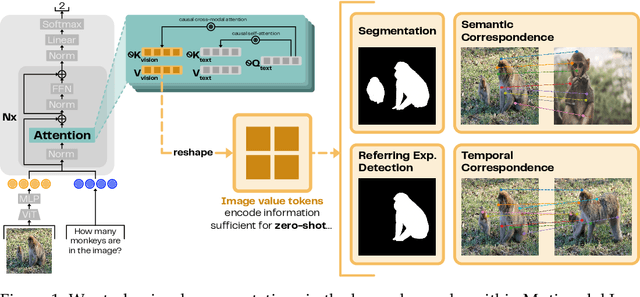



Abstract:Despite interpretability work analyzing VIT encoders and transformer activations, we don't yet understand why Multimodal Language Models (MLMs) struggle on perception-heavy tasks. We offer an under-studied perspective by examining how popular MLMs (LLaVA-OneVision, Qwen2.5-VL, and Llama-3-LLaVA-NeXT) process their visual key-value tokens. We first study the flow of visual information through the language model, finding that image value tokens encode sufficient information to perform several perception-heavy tasks zero-shot: segmentation, semantic correspondence, temporal correspondence, and referring expression detection. We find that while the language model does augment the visual information received from the projection of input visual encodings-which we reveal correlates with overall MLM perception capability-it contains less visual information on several tasks than the equivalent visual encoder (SigLIP) that has not undergone MLM finetuning. Further, we find that the visual information corresponding to input-agnostic image key tokens in later layers of language models contains artifacts which reduce perception capability of the overall MLM. Next, we discuss controlling visual information in the language model, showing that adding a text prefix to the image input improves perception capabilities of visual representations. Finally, we reveal that if language models were able to better control their visual information, their perception would significantly improve; e.g., in 33.3% of Art Style questions in the BLINK benchmark, perception information present in the language model is not surfaced to the output! Our findings reveal insights into the role of key-value tokens in multimodal systems, paving the way for deeper mechanistic interpretability of MLMs and suggesting new directions for training their visual encoder and language model components.
LiveVQA: Live Visual Knowledge Seeking
Apr 07, 2025Abstract:We introduce LiveVQA, an automatically collected dataset of latest visual knowledge from the Internet with synthesized VQA problems. LiveVQA consists of 3,602 single- and multi-hop visual questions from 6 news websites across 14 news categories, featuring high-quality image-text coherence and authentic information. Our evaluation across 15 MLLMs (e.g., GPT-4o, Gemma-3, and Qwen-2.5-VL family) demonstrates that stronger models perform better overall, with advanced visual reasoning capabilities proving crucial for complex multi-hop questions. Despite excellent performance on textual problems, models with tools like search engines still show significant gaps when addressing visual questions requiring latest visual knowledge, highlighting important areas for future research.
Interleaved Scene Graph for Interleaved Text-and-Image Generation Assessment
Nov 26, 2024Abstract:Many real-world user queries (e.g. "How do to make egg fried rice?") could benefit from systems capable of generating responses with both textual steps with accompanying images, similar to a cookbook. Models designed to generate interleaved text and images face challenges in ensuring consistency within and across these modalities. To address these challenges, we present ISG, a comprehensive evaluation framework for interleaved text-and-image generation. ISG leverages a scene graph structure to capture relationships between text and image blocks, evaluating responses on four levels of granularity: holistic, structural, block-level, and image-specific. This multi-tiered evaluation allows for a nuanced assessment of consistency, coherence, and accuracy, and provides interpretable question-answer feedback. In conjunction with ISG, we introduce a benchmark, ISG-Bench, encompassing 1,150 samples across 8 categories and 21 subcategories. This benchmark dataset includes complex language-vision dependencies and golden answers to evaluate models effectively on vision-centric tasks such as style transfer, a challenging area for current models. Using ISG-Bench, we demonstrate that recent unified vision-language models perform poorly on generating interleaved content. While compositional approaches that combine separate language and image models show a 111% improvement over unified models at the holistic level, their performance remains suboptimal at both block and image levels. To facilitate future work, we develop ISG-Agent, a baseline agent employing a "plan-execute-refine" pipeline to invoke tools, achieving a 122% performance improvement.
Coarse Correspondence Elicit 3D Spacetime Understanding in Multimodal Language Model
Aug 01, 2024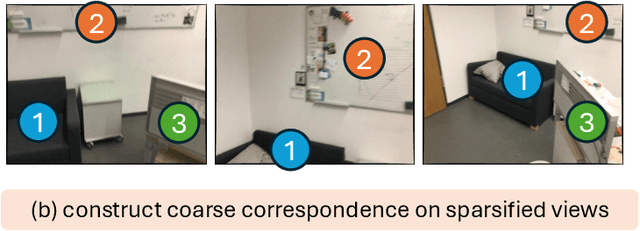
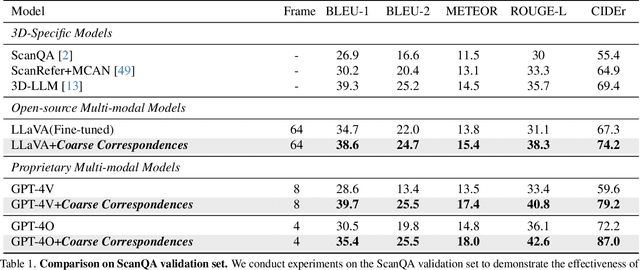
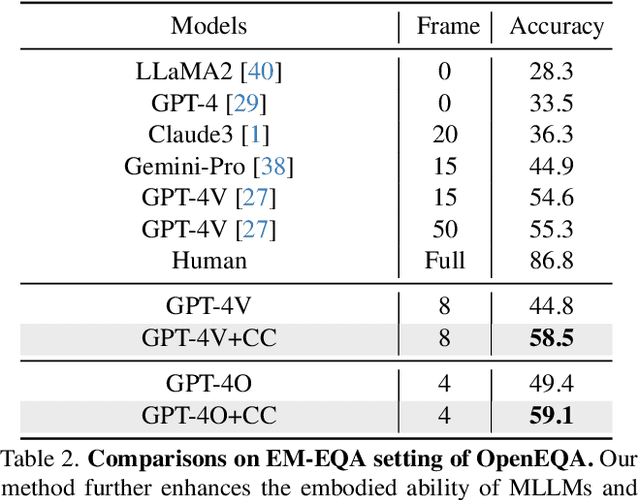
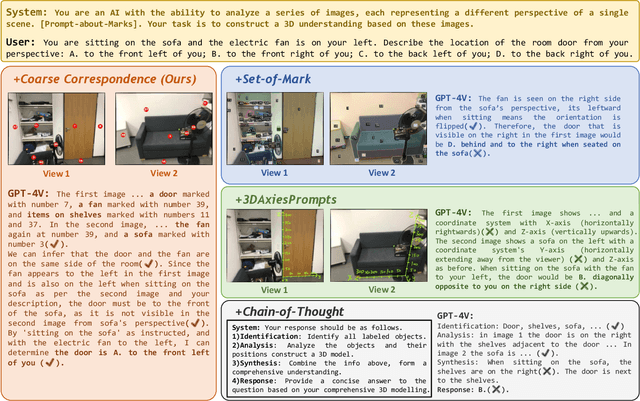
Abstract:Multimodal language models (MLLMs) are increasingly being implemented in real-world environments, necessitating their ability to interpret 3D spaces and comprehend temporal dynamics. Despite their potential, current top models within our community still fall short in adequately understanding spatial and temporal dimensions. We introduce Coarse Correspondence, a simple, training-free, effective, and general-purpose visual prompting method to elicit 3D and temporal understanding in multimodal LLMs. Our method uses a lightweight tracking model to find object correspondences between frames in a video or between sets of image viewpoints. It selects the most frequent object instances and visualizes them with markers with unique IDs in the image. With this simple approach, we achieve state-of-the-art results on 3D understanding benchmarks including ScanQA (+20.5\%) and a subset of OpenEQA (+9.7\%), and on long-form video benchmarks such as EgoSchema (+6.0\%). We also curate a small diagnostic dataset to evaluate whether MLLMs can reason about space from a described viewpoint other than the camera viewpoint. Again, Coarse Correspondence improves spatial perspective-taking abilities but we highlight that MLLMs struggle with this task. Together, we demonstrate that our simple prompting method can significantly aid downstream tasks that require 3D or temporal reasoning.
Efficient Inference of Vision Instruction-Following Models with Elastic Cache
Jul 25, 2024Abstract:In the field of instruction-following large vision-language models (LVLMs), the efficient deployment of these models faces challenges, notably due to the high memory demands of their key-value (KV) caches. Conventional cache management strategies for LLMs focus on cache eviction, which often fails to address the specific needs of multimodal instruction-following models. Recognizing this gap, in this paper, we introduce Elastic Cache, a novel approach that benefits from applying distinct acceleration methods for instruction encoding and output generation stages. We investigate the metrics of importance in different stages and propose an importance-driven cache merging strategy to prune redundancy caches. Instead of discarding less important caches, our strategy identifies important key/value vectors as anchor points. Surrounding less important caches are then merged with these anchors, enhancing the preservation of contextual information in the KV caches while yielding an arbitrary acceleration ratio. For instruction encoding, we utilize the frequency to evaluate the importance of caches. Regarding output generation, we prioritize tokens based on their distance with an offset, by which both the initial and most recent tokens are retained. Results on a range of LVLMs demonstrate that Elastic Cache not only boosts efficiency but also notably outperforms existing pruning methods in language generation across various tasks. Code is available at https://github.com/liuzuyan/ElasticCache
Matching-based Data Valuation for Generative Model
Apr 21, 2023Abstract:Data valuation is critical in machine learning, as it helps enhance model transparency and protect data properties. Existing data valuation methods have primarily focused on discriminative models, neglecting deep generative models that have recently gained considerable attention. Similar to discriminative models, there is an urgent need to assess data contributions in deep generative models as well. However, previous data valuation approaches mainly relied on discriminative model performance metrics and required model retraining. Consequently, they cannot be applied directly and efficiently to recent deep generative models, such as generative adversarial networks and diffusion models, in practice. To bridge this gap, we formulate the data valuation problem in generative models from a similarity-matching perspective. Specifically, we introduce Generative Model Valuator (GMValuator), the first model-agnostic approach for any generative models, designed to provide data valuation for generation tasks. We have conducted extensive experiments to demonstrate the effectiveness of the proposed method. To the best of their knowledge, GMValuator is the first work that offers a training-free, post-hoc data valuation strategy for deep generative models.
TIFA: Accurate and Interpretable Text-to-Image Faithfulness Evaluation with Question Answering
Mar 28, 2023Abstract:Despite thousands of researchers, engineers, and artists actively working on improving text-to-image generation models, systems often fail to produce images that accurately align with the text inputs. We introduce TIFA (Text-to-Image Faithfulness evaluation with question Answering), an automatic evaluation metric that measures the faithfulness of a generated image to its text input via visual question answering (VQA). Specifically, given a text input, we automatically generate several question-answer pairs using a language model. We calculate image faithfulness by checking whether existing VQA models can answer these questions using the generated image. TIFA is a reference-free metric that allows for fine-grained and interpretable evaluations of generated images. TIFA also has better correlations with human judgments than existing metrics. Based on this approach, we introduce TIFA v1.0, a benchmark consisting of 4K diverse text inputs and 25K questions across 12 categories (object, counting, etc.). We present a comprehensive evaluation of existing text-to-image models using TIFA v1.0 and highlight the limitations and challenges of current models. For instance, we find that current text-to-image models, despite doing well on color and material, still struggle in counting, spatial relations, and composing multiple objects. We hope our benchmark will help carefully measure the research progress in text-to-image synthesis and provide valuable insights for further research.
Unleashing Text-to-Image Diffusion Models for Visual Perception
Mar 03, 2023Abstract:Diffusion models (DMs) have become the new trend of generative models and have demonstrated a powerful ability of conditional synthesis. Among those, text-to-image diffusion models pre-trained on large-scale image-text pairs are highly controllable by customizable prompts. Unlike the unconditional generative models that focus on low-level attributes and details, text-to-image diffusion models contain more high-level knowledge thanks to the vision-language pre-training. In this paper, we propose VPD (Visual Perception with a pre-trained Diffusion model), a new framework that exploits the semantic information of a pre-trained text-to-image diffusion model in visual perception tasks. Instead of using the pre-trained denoising autoencoder in a diffusion-based pipeline, we simply use it as a backbone and aim to study how to take full advantage of the learned knowledge. Specifically, we prompt the denoising decoder with proper textual inputs and refine the text features with an adapter, leading to a better alignment to the pre-trained stage and making the visual contents interact with the text prompts. We also propose to utilize the cross-attention maps between the visual features and the text features to provide explicit guidance. Compared with other pre-training methods, we show that vision-language pre-trained diffusion models can be faster adapted to downstream visual perception tasks using the proposed VPD. Extensive experiments on semantic segmentation, referring image segmentation and depth estimation demonstrates the effectiveness of our method. Notably, VPD attains 0.254 RMSE on NYUv2 depth estimation and 73.3% oIoU on RefCOCO-val referring image segmentation, establishing new records on these two benchmarks. Code is available at https://github.com/wl-zhao/VPD
RandomRooms: Unsupervised Pre-training from Synthetic Shapes and Randomized Layouts for 3D Object Detection
Aug 17, 2021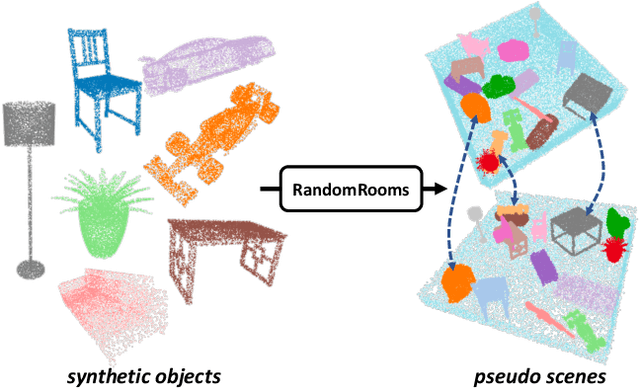

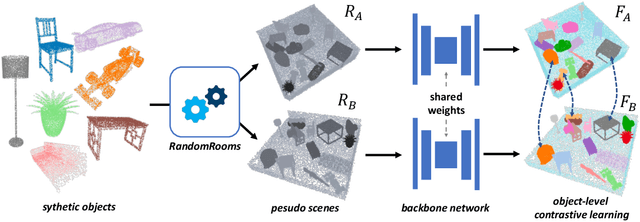
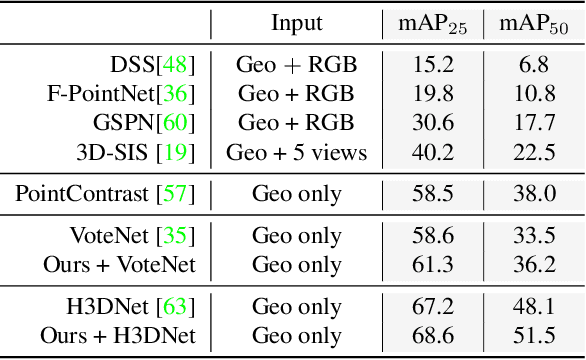
Abstract:3D point cloud understanding has made great progress in recent years. However, one major bottleneck is the scarcity of annotated real datasets, especially compared to 2D object detection tasks, since a large amount of labor is involved in annotating the real scans of a scene. A promising solution to this problem is to make better use of the synthetic dataset, which consists of CAD object models, to boost the learning on real datasets. This can be achieved by the pre-training and fine-tuning procedure. However, recent work on 3D pre-training exhibits failure when transfer features learned on synthetic objects to other real-world applications. In this work, we put forward a new method called RandomRooms to accomplish this objective. In particular, we propose to generate random layouts of a scene by making use of the objects in the synthetic CAD dataset and learn the 3D scene representation by applying object-level contrastive learning on two random scenes generated from the same set of synthetic objects. The model pre-trained in this way can serve as a better initialization when later fine-tuning on the 3D object detection task. Empirically, we show consistent improvement in downstream 3D detection tasks on several base models, especially when less training data are used, which strongly demonstrates the effectiveness and generalization of our method. Benefiting from the rich semantic knowledge and diverse objects from synthetic data, our method establishes the new state-of-the-art on widely-used 3D detection benchmarks ScanNetV2 and SUN RGB-D. We expect our attempt to provide a new perspective for bridging object and scene-level 3D understanding.
DynamicViT: Efficient Vision Transformers with Dynamic Token Sparsification
Jun 03, 2021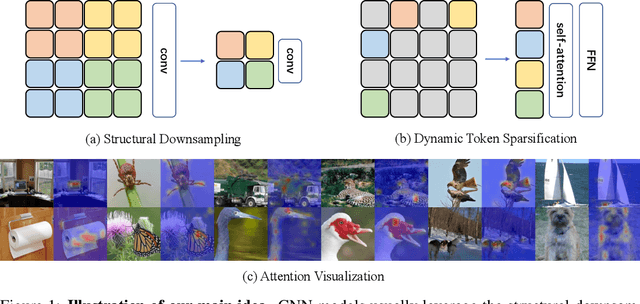
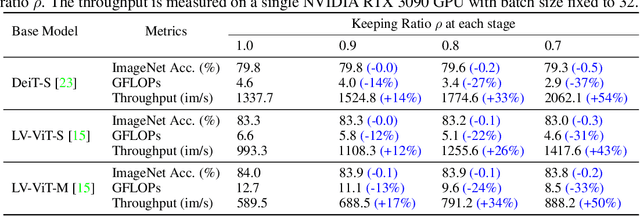
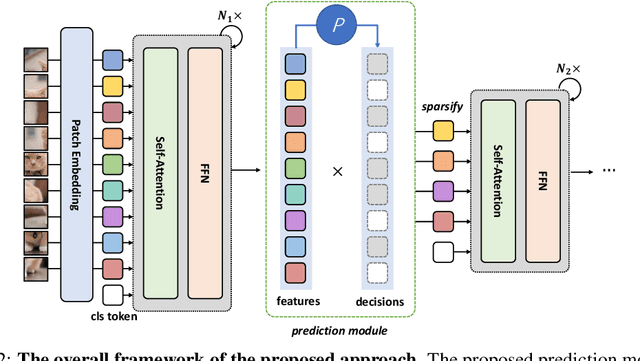
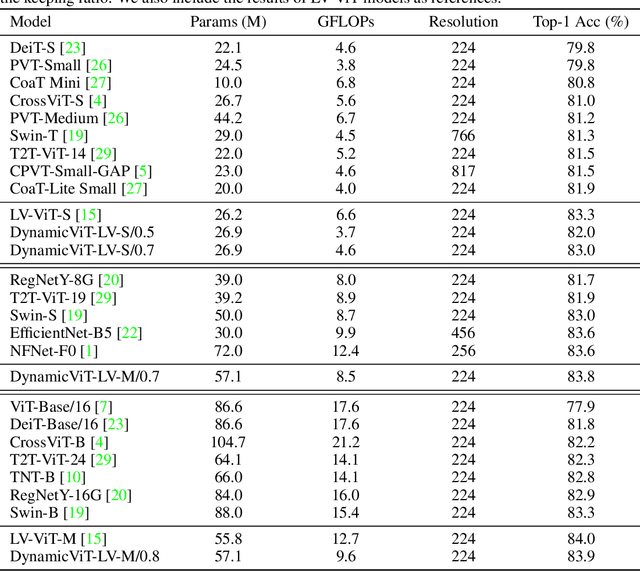
Abstract:Attention is sparse in vision transformers. We observe the final prediction in vision transformers is only based on a subset of most informative tokens, which is sufficient for accurate image recognition. Based on this observation, we propose a dynamic token sparsification framework to prune redundant tokens progressively and dynamically based on the input. Specifically, we devise a lightweight prediction module to estimate the importance score of each token given the current features. The module is added to different layers to prune redundant tokens hierarchically. To optimize the prediction module in an end-to-end manner, we propose an attention masking strategy to differentiably prune a token by blocking its interactions with other tokens. Benefiting from the nature of self-attention, the unstructured sparse tokens are still hardware friendly, which makes our framework easy to achieve actual speed-up. By hierarchically pruning 66% of the input tokens, our method greatly reduces 31%~37% FLOPs and improves the throughput by over 40% while the drop of accuracy is within 0.5% for various vision transformers. Equipped with the dynamic token sparsification framework, DynamicViT models can achieve very competitive complexity/accuracy trade-offs compared to state-of-the-art CNNs and vision transformers on ImageNet. Code is available at https://github.com/raoyongming/DynamicViT
 Add to Chrome
Add to Chrome Add to Firefox
Add to Firefox Add to Edge
Add to Edge